EDU20004: Understanding the Factors Affecting Student Behaviour
VerifiedAdded on 2023/06/10
|9
|2173
|227
Essay
AI Summary
This essay examines the multifaceted factors influencing student behavior, focusing on both internal elements like mental health difficulties and external influences such as cultural background, gender, and socioeconomic status. It delves into the impact of individual differences, psychological factors, family structures, and environmental conditions on student conduct. The essay also incorporates a behavioral theory, illustrating how conditioning and reinforcement shape learning and behavior. It highlights the significance of addressing mental health issues in students and fostering a supportive learning environment that acknowledges and accommodates diverse needs and circumstances. The conclusion emphasizes the importance of teachers recognizing and addressing potential mental health concerns and understanding the various factors that contribute to behavioral differences among students. Desklib provides resources for students, including solved assignments.
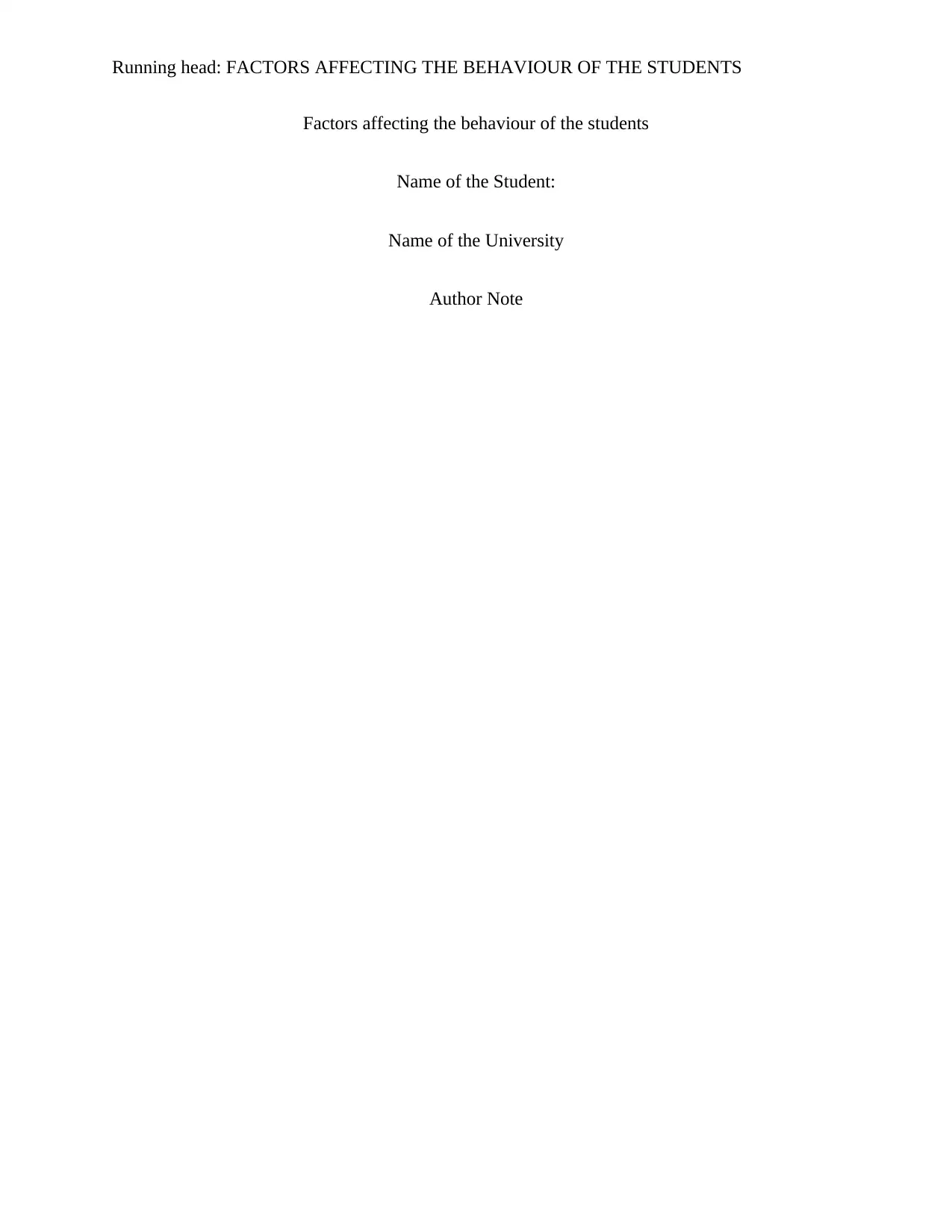
Running head: FACTORS AFFECTING THE BEHAVIOUR OF THE STUDENTS
Factors affecting the behaviour of the students
Name of the Student:
Name of the University
Author Note
Factors affecting the behaviour of the students
Name of the Student:
Name of the University
Author Note
Paraphrase This Document
Need a fresh take? Get an instant paraphrase of this document with our AI Paraphraser

1
Introduction:
Behaviour can be defined as the range of actions or behaviours made by an individual
depending on the set of behavioural norms set by the society or surrounding environment of the
individual. Behaviour is termed as a response or reflex action of certain kind of situation
presented in front of the subject of the individual, where the situation can be internal or external,
conscious or subconscious, voluntary or involuntary. This paper is going to deal with internal
and external factors that influence the behaviour in the students like Mental Health Difficulties
(MHD) and other internal factors like culture, tradition, gender, physical abilities, monetary
income and many more which will help in the development of interpersonal and intrapersonal
behaviours of the students. This paper also presents a theory of behaviour with examples for
better understanding and it will also help in knowing about behaviour in an individual more
precisely.
Discussion:
In behaviour learning, many theorists believe that learning has been completed when
there is a change of behaviour. In this learning model of behaviour, conditioning helps in the
process of learning. Conditioning is a process where a reward is given for a desired response
which acts as a motivator and increases the chance of getting the desired behaviour repeatedly.
Enforcement is an important part of the behaviourist approach. Continuous reinforcement for
desirable behaviour in every situation can result in an increase of repeated desirable response.
After the desirable behaviour is habituated, continuous and regular reinforcement maintains the
behaviour. This theory is often used in getting results like weight loss, smoking discontinuation
Introduction:
Behaviour can be defined as the range of actions or behaviours made by an individual
depending on the set of behavioural norms set by the society or surrounding environment of the
individual. Behaviour is termed as a response or reflex action of certain kind of situation
presented in front of the subject of the individual, where the situation can be internal or external,
conscious or subconscious, voluntary or involuntary. This paper is going to deal with internal
and external factors that influence the behaviour in the students like Mental Health Difficulties
(MHD) and other internal factors like culture, tradition, gender, physical abilities, monetary
income and many more which will help in the development of interpersonal and intrapersonal
behaviours of the students. This paper also presents a theory of behaviour with examples for
better understanding and it will also help in knowing about behaviour in an individual more
precisely.
Discussion:
In behaviour learning, many theorists believe that learning has been completed when
there is a change of behaviour. In this learning model of behaviour, conditioning helps in the
process of learning. Conditioning is a process where a reward is given for a desired response
which acts as a motivator and increases the chance of getting the desired behaviour repeatedly.
Enforcement is an important part of the behaviourist approach. Continuous reinforcement for
desirable behaviour in every situation can result in an increase of repeated desirable response.
After the desirable behaviour is habituated, continuous and regular reinforcement maintains the
behaviour. This theory is often used in getting results like weight loss, smoking discontinuation
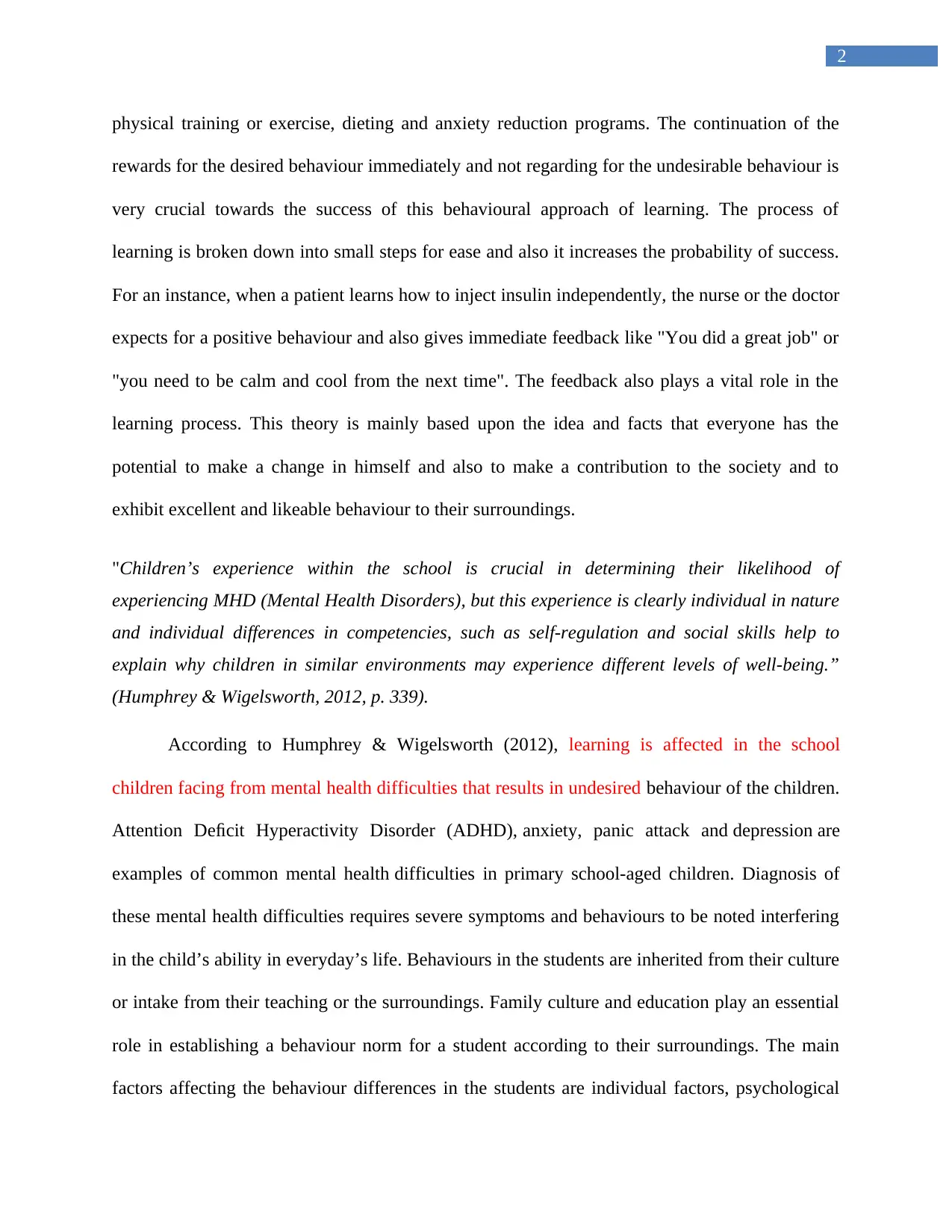
2
physical training or exercise, dieting and anxiety reduction programs. The continuation of the
rewards for the desired behaviour immediately and not regarding for the undesirable behaviour is
very crucial towards the success of this behavioural approach of learning. The process of
learning is broken down into small steps for ease and also it increases the probability of success.
For an instance, when a patient learns how to inject insulin independently, the nurse or the doctor
expects for a positive behaviour and also gives immediate feedback like "You did a great job" or
"you need to be calm and cool from the next time". The feedback also plays a vital role in the
learning process. This theory is mainly based upon the idea and facts that everyone has the
potential to make a change in himself and also to make a contribution to the society and to
exhibit excellent and likeable behaviour to their surroundings.
"Children’s experience within the school is crucial in determining their likelihood of
experiencing MHD (Mental Health Disorders), but this experience is clearly individual in nature
and individual differences in competencies, such as self-regulation and social skills help to
explain why children in similar environments may experience different levels of well-being.”
(Humphrey & Wigelsworth, 2012, p. 339).
According to Humphrey & Wigelsworth (2012), learning is affected in the school
children facing from mental health difficulties that results in undesired behaviour of the children.
Attention Deficit Hyperactivity Disorder (ADHD), anxiety, panic attack and depression are
examples of common mental health difficulties in primary school-aged children. Diagnosis of
these mental health difficulties requires severe symptoms and behaviours to be noted interfering
in the child’s ability in everyday’s life. Behaviours in the students are inherited from their culture
or intake from their teaching or the surroundings. Family culture and education play an essential
role in establishing a behaviour norm for a student according to their surroundings. The main
factors affecting the behaviour differences in the students are individual factors, psychological
physical training or exercise, dieting and anxiety reduction programs. The continuation of the
rewards for the desired behaviour immediately and not regarding for the undesirable behaviour is
very crucial towards the success of this behavioural approach of learning. The process of
learning is broken down into small steps for ease and also it increases the probability of success.
For an instance, when a patient learns how to inject insulin independently, the nurse or the doctor
expects for a positive behaviour and also gives immediate feedback like "You did a great job" or
"you need to be calm and cool from the next time". The feedback also plays a vital role in the
learning process. This theory is mainly based upon the idea and facts that everyone has the
potential to make a change in himself and also to make a contribution to the society and to
exhibit excellent and likeable behaviour to their surroundings.
"Children’s experience within the school is crucial in determining their likelihood of
experiencing MHD (Mental Health Disorders), but this experience is clearly individual in nature
and individual differences in competencies, such as self-regulation and social skills help to
explain why children in similar environments may experience different levels of well-being.”
(Humphrey & Wigelsworth, 2012, p. 339).
According to Humphrey & Wigelsworth (2012), learning is affected in the school
children facing from mental health difficulties that results in undesired behaviour of the children.
Attention Deficit Hyperactivity Disorder (ADHD), anxiety, panic attack and depression are
examples of common mental health difficulties in primary school-aged children. Diagnosis of
these mental health difficulties requires severe symptoms and behaviours to be noted interfering
in the child’s ability in everyday’s life. Behaviours in the students are inherited from their culture
or intake from their teaching or the surroundings. Family culture and education play an essential
role in establishing a behaviour norm for a student according to their surroundings. The main
factors affecting the behaviour differences in the students are individual factors, psychological
⊘ This is a preview!⊘
Do you want full access?
Subscribe today to unlock all pages.

Trusted by 1+ million students worldwide
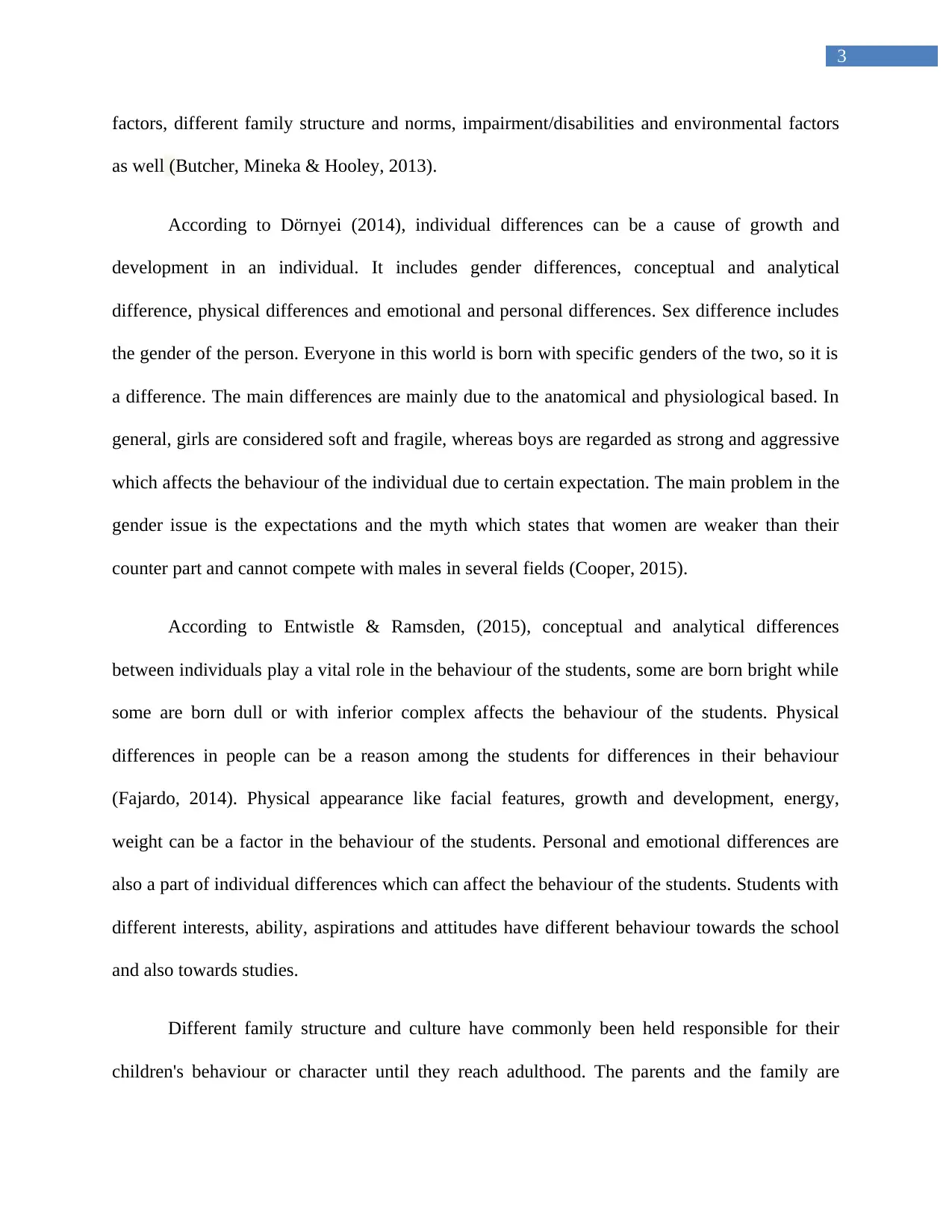
3
factors, different family structure and norms, impairment/disabilities and environmental factors
as well (Butcher, Mineka & Hooley, 2013).
According to Dörnyei (2014), individual differences can be a cause of growth and
development in an individual. It includes gender differences, conceptual and analytical
difference, physical differences and emotional and personal differences. Sex difference includes
the gender of the person. Everyone in this world is born with specific genders of the two, so it is
a difference. The main differences are mainly due to the anatomical and physiological based. In
general, girls are considered soft and fragile, whereas boys are regarded as strong and aggressive
which affects the behaviour of the individual due to certain expectation. The main problem in the
gender issue is the expectations and the myth which states that women are weaker than their
counter part and cannot compete with males in several fields (Cooper, 2015).
According to Entwistle & Ramsden, (2015), conceptual and analytical differences
between individuals play a vital role in the behaviour of the students, some are born bright while
some are born dull or with inferior complex affects the behaviour of the students. Physical
differences in people can be a reason among the students for differences in their behaviour
(Fajardo, 2014). Physical appearance like facial features, growth and development, energy,
weight can be a factor in the behaviour of the students. Personal and emotional differences are
also a part of individual differences which can affect the behaviour of the students. Students with
different interests, ability, aspirations and attitudes have different behaviour towards the school
and also towards studies.
Different family structure and culture have commonly been held responsible for their
children's behaviour or character until they reach adulthood. The parents and the family are
factors, different family structure and norms, impairment/disabilities and environmental factors
as well (Butcher, Mineka & Hooley, 2013).
According to Dörnyei (2014), individual differences can be a cause of growth and
development in an individual. It includes gender differences, conceptual and analytical
difference, physical differences and emotional and personal differences. Sex difference includes
the gender of the person. Everyone in this world is born with specific genders of the two, so it is
a difference. The main differences are mainly due to the anatomical and physiological based. In
general, girls are considered soft and fragile, whereas boys are regarded as strong and aggressive
which affects the behaviour of the individual due to certain expectation. The main problem in the
gender issue is the expectations and the myth which states that women are weaker than their
counter part and cannot compete with males in several fields (Cooper, 2015).
According to Entwistle & Ramsden, (2015), conceptual and analytical differences
between individuals play a vital role in the behaviour of the students, some are born bright while
some are born dull or with inferior complex affects the behaviour of the students. Physical
differences in people can be a reason among the students for differences in their behaviour
(Fajardo, 2014). Physical appearance like facial features, growth and development, energy,
weight can be a factor in the behaviour of the students. Personal and emotional differences are
also a part of individual differences which can affect the behaviour of the students. Students with
different interests, ability, aspirations and attitudes have different behaviour towards the school
and also towards studies.
Different family structure and culture have commonly been held responsible for their
children's behaviour or character until they reach adulthood. The parents and the family are
Paraphrase This Document
Need a fresh take? Get an instant paraphrase of this document with our AI Paraphraser
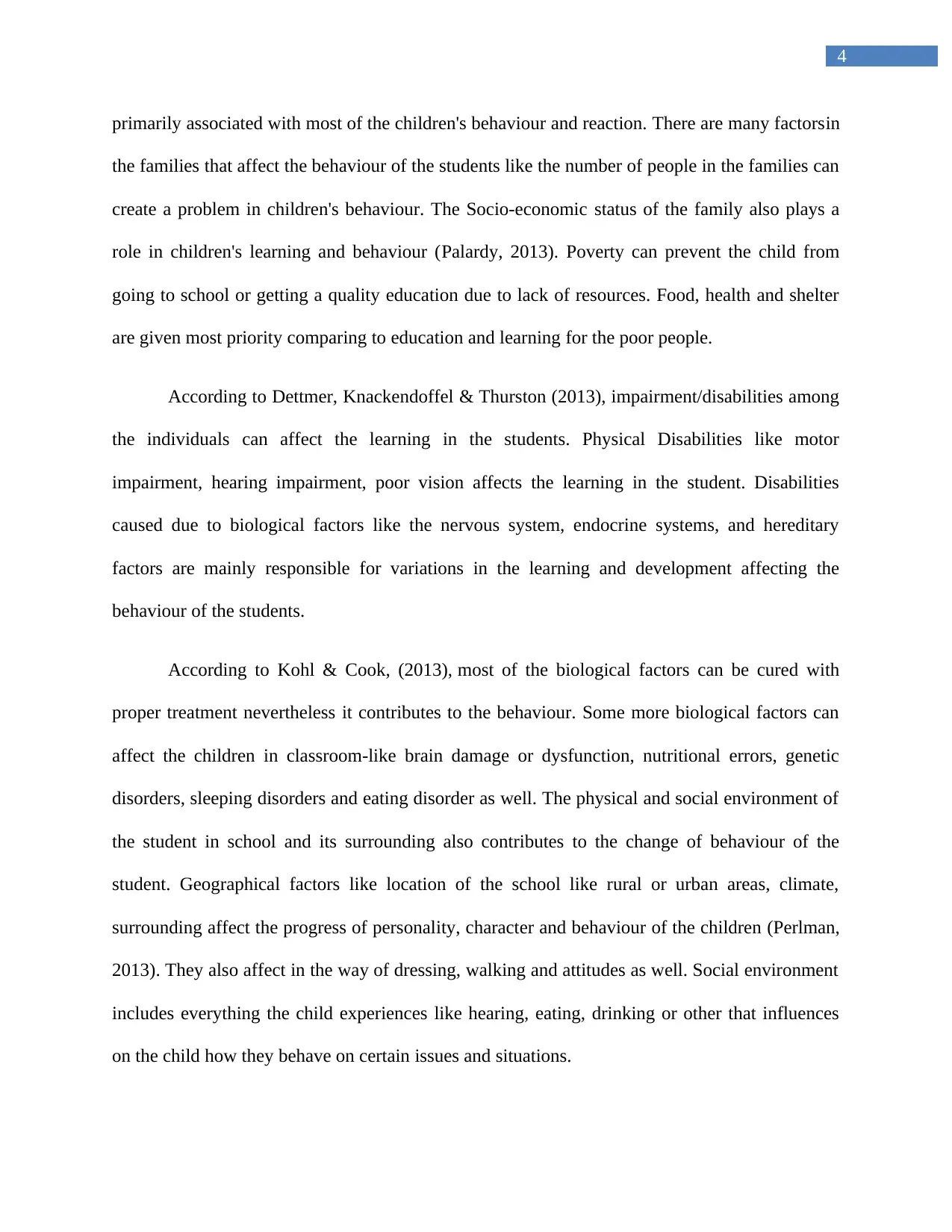
4
primarily associated with most of the children's behaviour and reaction. There are many factorsin
the families that affect the behaviour of the students like the number of people in the families can
create a problem in children's behaviour. The Socio-economic status of the family also plays a
role in children's learning and behaviour (Palardy, 2013). Poverty can prevent the child from
going to school or getting a quality education due to lack of resources. Food, health and shelter
are given most priority comparing to education and learning for the poor people.
According to Dettmer, Knackendoffel & Thurston (2013), impairment/disabilities among
the individuals can affect the learning in the students. Physical Disabilities like motor
impairment, hearing impairment, poor vision affects the learning in the student. Disabilities
caused due to biological factors like the nervous system, endocrine systems, and hereditary
factors are mainly responsible for variations in the learning and development affecting the
behaviour of the students.
According to Kohl & Cook, (2013), most of the biological factors can be cured with
proper treatment nevertheless it contributes to the behaviour. Some more biological factors can
affect the children in classroom-like brain damage or dysfunction, nutritional errors, genetic
disorders, sleeping disorders and eating disorder as well. The physical and social environment of
the student in school and its surrounding also contributes to the change of behaviour of the
student. Geographical factors like location of the school like rural or urban areas, climate,
surrounding affect the progress of personality, character and behaviour of the children (Perlman,
2013). They also affect in the way of dressing, walking and attitudes as well. Social environment
includes everything the child experiences like hearing, eating, drinking or other that influences
on the child how they behave on certain issues and situations.
primarily associated with most of the children's behaviour and reaction. There are many factorsin
the families that affect the behaviour of the students like the number of people in the families can
create a problem in children's behaviour. The Socio-economic status of the family also plays a
role in children's learning and behaviour (Palardy, 2013). Poverty can prevent the child from
going to school or getting a quality education due to lack of resources. Food, health and shelter
are given most priority comparing to education and learning for the poor people.
According to Dettmer, Knackendoffel & Thurston (2013), impairment/disabilities among
the individuals can affect the learning in the students. Physical Disabilities like motor
impairment, hearing impairment, poor vision affects the learning in the student. Disabilities
caused due to biological factors like the nervous system, endocrine systems, and hereditary
factors are mainly responsible for variations in the learning and development affecting the
behaviour of the students.
According to Kohl & Cook, (2013), most of the biological factors can be cured with
proper treatment nevertheless it contributes to the behaviour. Some more biological factors can
affect the children in classroom-like brain damage or dysfunction, nutritional errors, genetic
disorders, sleeping disorders and eating disorder as well. The physical and social environment of
the student in school and its surrounding also contributes to the change of behaviour of the
student. Geographical factors like location of the school like rural or urban areas, climate,
surrounding affect the progress of personality, character and behaviour of the children (Perlman,
2013). They also affect in the way of dressing, walking and attitudes as well. Social environment
includes everything the child experiences like hearing, eating, drinking or other that influences
on the child how they behave on certain issues and situations.
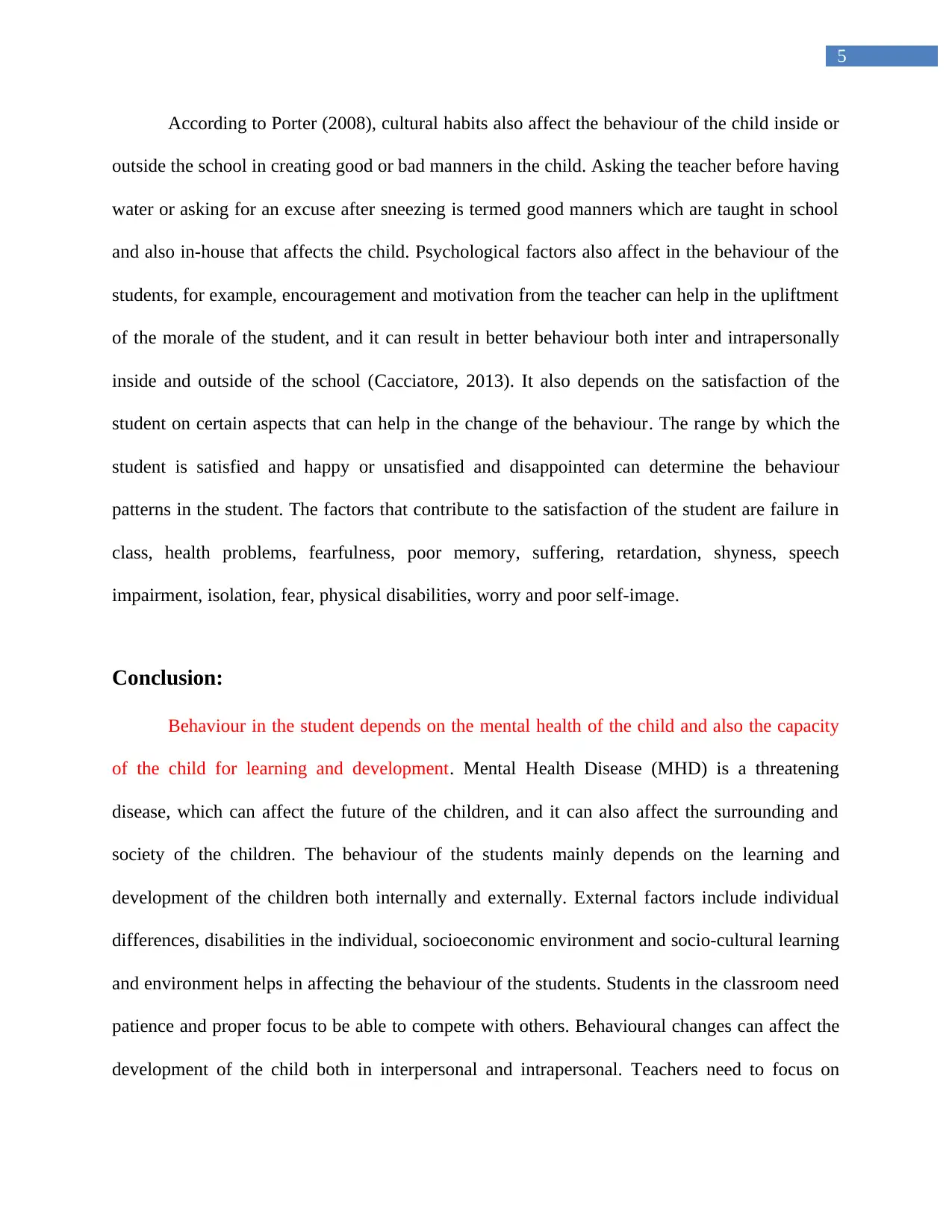
5
According to Porter (2008), cultural habits also affect the behaviour of the child inside or
outside the school in creating good or bad manners in the child. Asking the teacher before having
water or asking for an excuse after sneezing is termed good manners which are taught in school
and also in-house that affects the child. Psychological factors also affect in the behaviour of the
students, for example, encouragement and motivation from the teacher can help in the upliftment
of the morale of the student, and it can result in better behaviour both inter and intrapersonally
inside and outside of the school (Cacciatore, 2013). It also depends on the satisfaction of the
student on certain aspects that can help in the change of the behaviour. The range by which the
student is satisfied and happy or unsatisfied and disappointed can determine the behaviour
patterns in the student. The factors that contribute to the satisfaction of the student are failure in
class, health problems, fearfulness, poor memory, suffering, retardation, shyness, speech
impairment, isolation, fear, physical disabilities, worry and poor self-image.
Conclusion:
Behaviour in the student depends on the mental health of the child and also the capacity
of the child for learning and development. Mental Health Disease (MHD) is a threatening
disease, which can affect the future of the children, and it can also affect the surrounding and
society of the children. The behaviour of the students mainly depends on the learning and
development of the children both internally and externally. External factors include individual
differences, disabilities in the individual, socioeconomic environment and socio-cultural learning
and environment helps in affecting the behaviour of the students. Students in the classroom need
patience and proper focus to be able to compete with others. Behavioural changes can affect the
development of the child both in interpersonal and intrapersonal. Teachers need to focus on
According to Porter (2008), cultural habits also affect the behaviour of the child inside or
outside the school in creating good or bad manners in the child. Asking the teacher before having
water or asking for an excuse after sneezing is termed good manners which are taught in school
and also in-house that affects the child. Psychological factors also affect in the behaviour of the
students, for example, encouragement and motivation from the teacher can help in the upliftment
of the morale of the student, and it can result in better behaviour both inter and intrapersonally
inside and outside of the school (Cacciatore, 2013). It also depends on the satisfaction of the
student on certain aspects that can help in the change of the behaviour. The range by which the
student is satisfied and happy or unsatisfied and disappointed can determine the behaviour
patterns in the student. The factors that contribute to the satisfaction of the student are failure in
class, health problems, fearfulness, poor memory, suffering, retardation, shyness, speech
impairment, isolation, fear, physical disabilities, worry and poor self-image.
Conclusion:
Behaviour in the student depends on the mental health of the child and also the capacity
of the child for learning and development. Mental Health Disease (MHD) is a threatening
disease, which can affect the future of the children, and it can also affect the surrounding and
society of the children. The behaviour of the students mainly depends on the learning and
development of the children both internally and externally. External factors include individual
differences, disabilities in the individual, socioeconomic environment and socio-cultural learning
and environment helps in affecting the behaviour of the students. Students in the classroom need
patience and proper focus to be able to compete with others. Behavioural changes can affect the
development of the child both in interpersonal and intrapersonal. Teachers need to focus on
⊘ This is a preview!⊘
Do you want full access?
Subscribe today to unlock all pages.

Trusted by 1+ million students worldwide
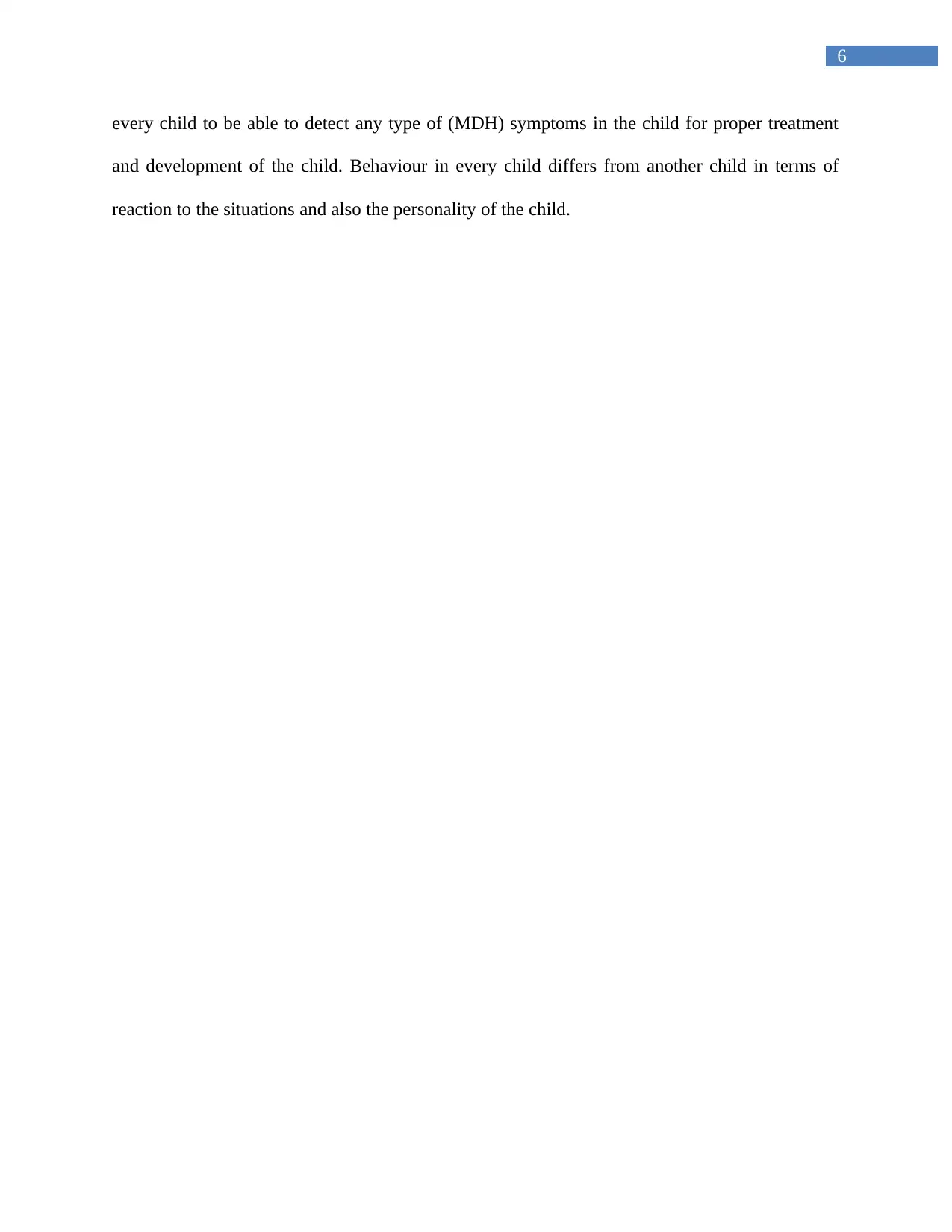
6
every child to be able to detect any type of (MDH) symptoms in the child for proper treatment
and development of the child. Behaviour in every child differs from another child in terms of
reaction to the situations and also the personality of the child.
every child to be able to detect any type of (MDH) symptoms in the child for proper treatment
and development of the child. Behaviour in every child differs from another child in terms of
reaction to the situations and also the personality of the child.
Paraphrase This Document
Need a fresh take? Get an instant paraphrase of this document with our AI Paraphraser
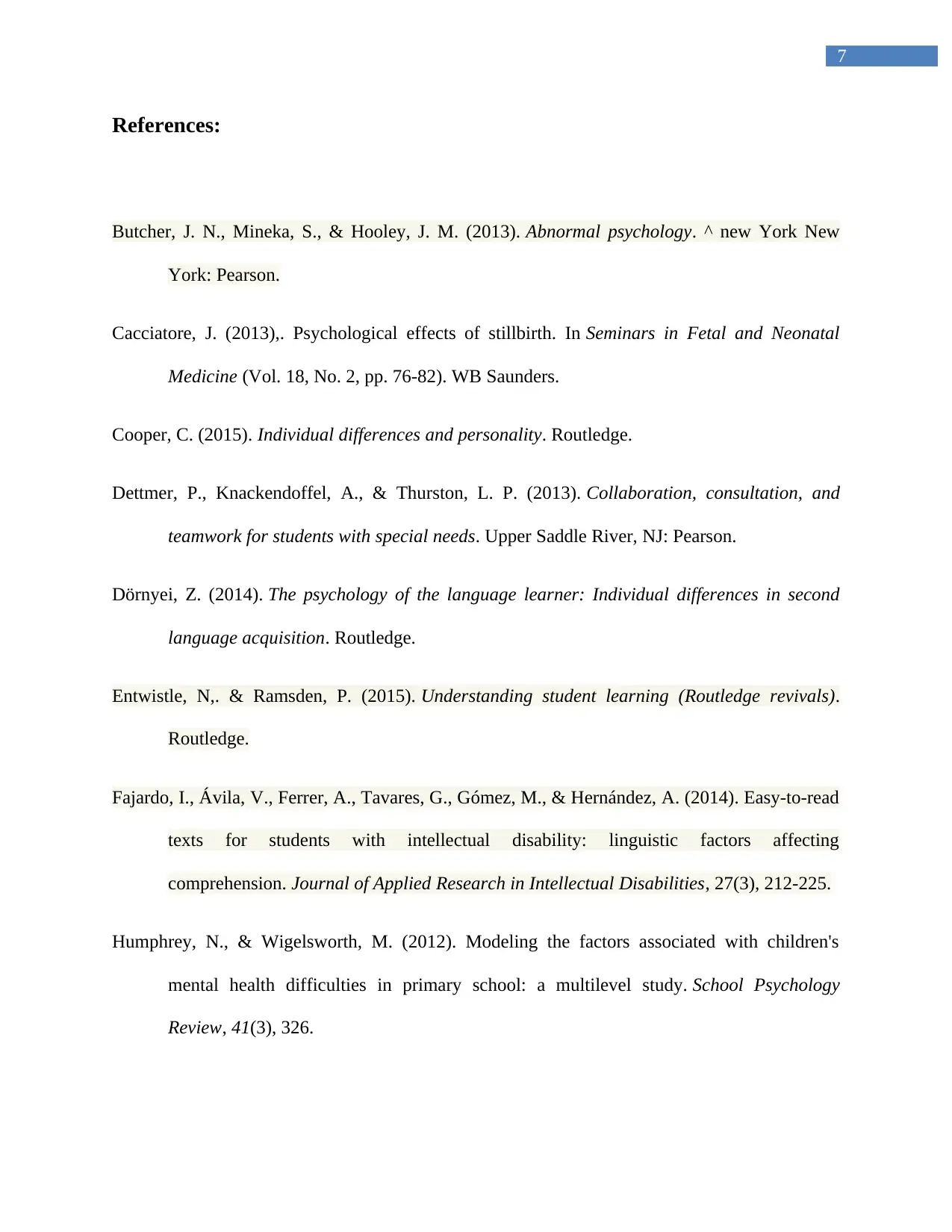
7
References:
Butcher, J. N., Mineka, S., & Hooley, J. M. (2013). Abnormal psychology. ^ new York New
York: Pearson.
Cacciatore, J. (2013),. Psychological effects of stillbirth. In Seminars in Fetal and Neonatal
Medicine (Vol. 18, No. 2, pp. 76-82). WB Saunders.
Cooper, C. (2015). Individual differences and personality. Routledge.
Dettmer, P., Knackendoffel, A., & Thurston, L. P. (2013). Collaboration, consultation, and
teamwork for students with special needs. Upper Saddle River, NJ: Pearson.
Dörnyei, Z. (2014). The psychology of the language learner: Individual differences in second
language acquisition. Routledge.
Entwistle, N,. & Ramsden, P. (2015). Understanding student learning (Routledge revivals).
Routledge.
Fajardo, I., Ávila, V., Ferrer, A., Tavares, G., Gómez, M., & Hernández, A. (2014). Easy‐to‐read
texts for students with intellectual disability: linguistic factors affecting
comprehension. Journal of Applied Research in Intellectual Disabilities, 27(3), 212-225.
Humphrey, N., & Wigelsworth, M. (2012). Modeling the factors associated with children's
mental health difficulties in primary school: a multilevel study. School Psychology
Review, 41(3), 326.
References:
Butcher, J. N., Mineka, S., & Hooley, J. M. (2013). Abnormal psychology. ^ new York New
York: Pearson.
Cacciatore, J. (2013),. Psychological effects of stillbirth. In Seminars in Fetal and Neonatal
Medicine (Vol. 18, No. 2, pp. 76-82). WB Saunders.
Cooper, C. (2015). Individual differences and personality. Routledge.
Dettmer, P., Knackendoffel, A., & Thurston, L. P. (2013). Collaboration, consultation, and
teamwork for students with special needs. Upper Saddle River, NJ: Pearson.
Dörnyei, Z. (2014). The psychology of the language learner: Individual differences in second
language acquisition. Routledge.
Entwistle, N,. & Ramsden, P. (2015). Understanding student learning (Routledge revivals).
Routledge.
Fajardo, I., Ávila, V., Ferrer, A., Tavares, G., Gómez, M., & Hernández, A. (2014). Easy‐to‐read
texts for students with intellectual disability: linguistic factors affecting
comprehension. Journal of Applied Research in Intellectual Disabilities, 27(3), 212-225.
Humphrey, N., & Wigelsworth, M. (2012). Modeling the factors associated with children's
mental health difficulties in primary school: a multilevel study. School Psychology
Review, 41(3), 326.
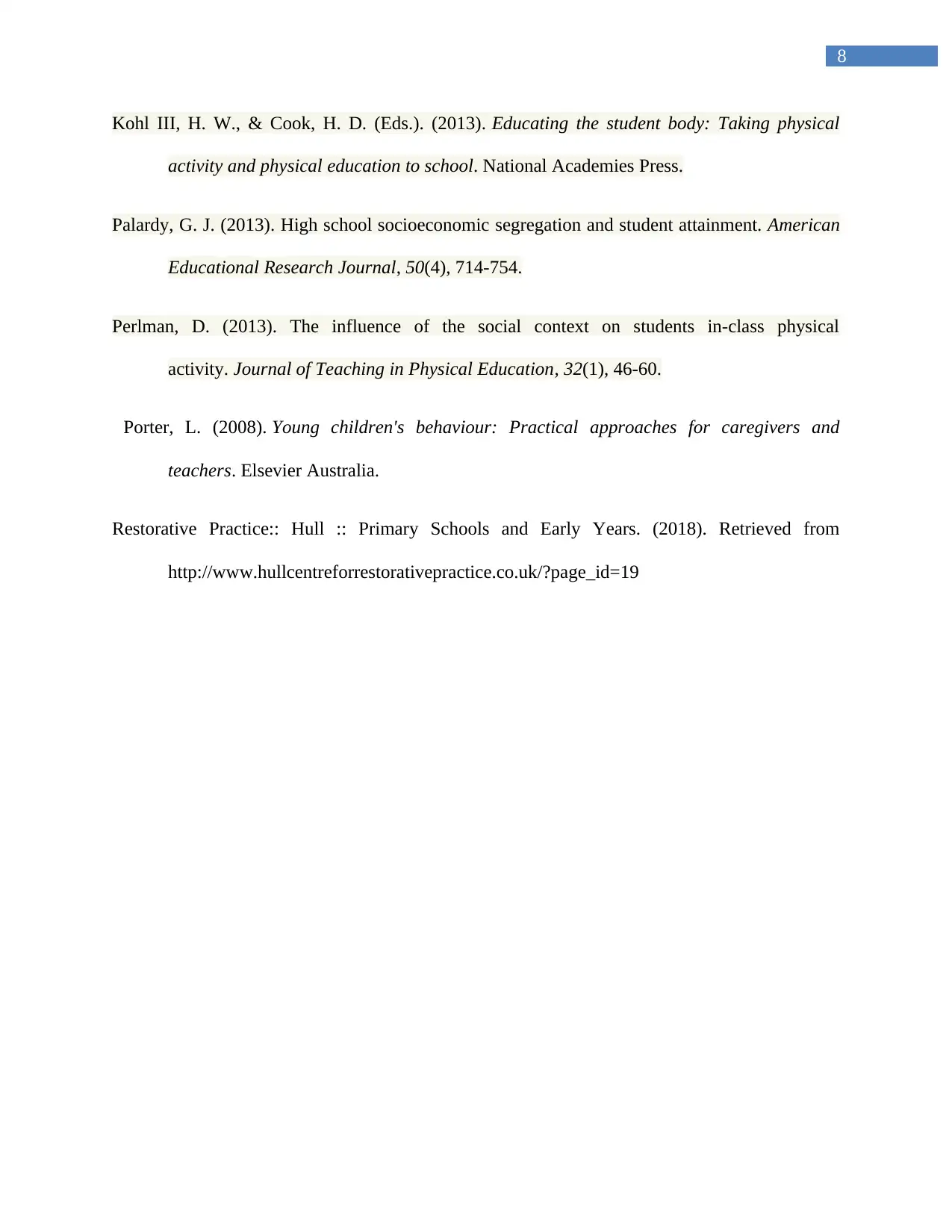
8
Kohl III, H. W., & Cook, H. D. (Eds.). (2013). Educating the student body: Taking physical
activity and physical education to school. National Academies Press.
Palardy, G. J. (2013). High school socioeconomic segregation and student attainment. American
Educational Research Journal, 50(4), 714-754.
Perlman, D. (2013). The influence of the social context on students in-class physical
activity. Journal of Teaching in Physical Education, 32(1), 46-60.
Porter, L. (2008). Young children's behaviour: Practical approaches for caregivers and
teachers. Elsevier Australia.
Restorative Practice:: Hull :: Primary Schools and Early Years. (2018). Retrieved from
http://www.hullcentreforrestorativepractice.co.uk/?page_id=19
Kohl III, H. W., & Cook, H. D. (Eds.). (2013). Educating the student body: Taking physical
activity and physical education to school. National Academies Press.
Palardy, G. J. (2013). High school socioeconomic segregation and student attainment. American
Educational Research Journal, 50(4), 714-754.
Perlman, D. (2013). The influence of the social context on students in-class physical
activity. Journal of Teaching in Physical Education, 32(1), 46-60.
Porter, L. (2008). Young children's behaviour: Practical approaches for caregivers and
teachers. Elsevier Australia.
Restorative Practice:: Hull :: Primary Schools and Early Years. (2018). Retrieved from
http://www.hullcentreforrestorativepractice.co.uk/?page_id=19
⊘ This is a preview!⊘
Do you want full access?
Subscribe today to unlock all pages.

Trusted by 1+ million students worldwide
1 out of 9
Related Documents
Your All-in-One AI-Powered Toolkit for Academic Success.
+13062052269
info@desklib.com
Available 24*7 on WhatsApp / Email
![[object Object]](/_next/static/media/star-bottom.7253800d.svg)
Unlock your academic potential
Copyright © 2020–2025 A2Z Services. All Rights Reserved. Developed and managed by ZUCOL.




